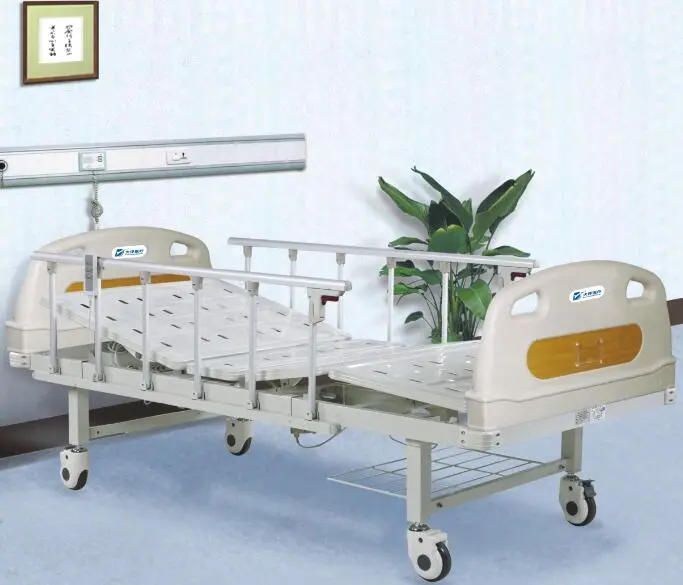—Why are hospital bed mattresses so important?
In a hospital nursing environment, hospital medical beds are not merely tools for patients to rest, but also an essential component of the treatment, care, and rehabilitation process.
The mattress, as the part in direct contact with the patient's body, plays a crucial role in comfort, safety, and the recovery process.
An unsuitable mattress can lead to:
• Excessive localized pressure → Increased risk of bedsores;
• Uneven support → Causes spinal or muscle discomfort;
• Poor ventilation → Leads to sweating, damp skin, and increased risk of infection;
• Difficulty in cleaning and maintenance → Affects infection control.
Therefore, the quality and type of hospital medical bed mattress directly affect the patient's recovery quality and medical safety.

What types of mattresses are commonly used in hospital beds?
Based on hospital needs and patient conditions, common hospital mattresses are mainly divided into the following categories:
• Ordinary foam mattress
• High-density foam mattress (memory foam)
• Anti-decubitus air mattress (air mattress)
• Waterbed
• Gel mattress
• Composite structure medical mattress (multi-layered materials)
Different types of mattresses have their own advantages and disadvantages, and are suitable for different groups of people and usage scenarios.
Below, we will conduct a systematic comparison from the perspectives of materials, support, breathability, and hygiene performance.
Is an ordinary foam mattress suitable for hospital medical beds?
Advantages of ordinary foam mattresses:
• Low cost and simple to manufacture;
• Lightweight and easy to move;
• Moderate softness, comfortable for initial use.
Disadvantages of ordinary foam mattresses:
• Insufficient support, prolonged bed rest may cause the body to sink in;
• Poor breathability, prone to heat accumulation and sweating;
• Difficult to clean, easily absorbs liquids;
• Not suitable for patients who are bedridden for extended periods or have limited mobility.
✅ Conclusion: Ordinary foam mattresses are only suitable for short-term hospital stays or recovery periods and are not recommended for long-term use as hospital medical bed mattresses.

Which hospital beds are suitable for high-density foam mattresses (memory foam)?
High-density foam mattresses are one of the commonly used upgraded mattresses in hospitals, widely used in rehabilitation wards and post-operative wards.
Advantages of high-density foam mattresses:
Good support and resilience
• Automatically distributes pressure according to the body's curves;
• Reduces contact stress between bones and the bed surface.
High comfort
• Conforms to the body shape, preventing localized pressure;
• Promotes blood circulation.
Antibacterial and waterproof cover
• Most models are equipped with a removable and washable medical cover;
• Impermeable design facilitates hospital cleaning and disinfection.
Suitable users
• Patients with limited mobility but good skin condition;
• Patients in recovery period after surgery or those on short-term bed rest.
Disadvantages of high-density foam mattresses:
• Slightly lower breathability; attention should be paid to heat dissipation during prolonged use;
• Slightly higher price than ordinary foam mattresses.
✅ Conclusion: High-density foam mattresses are a common mid-range choice for hospital medical beds, balancing comfort and support, and suitable for most general wards.
Is an anti-decubitus air mattress the "best choice" for hospital beds?
In modern medical institutions, anti-decubitus air mattresses (also known as medical air mattresses) are almost standard equipment for long-term bedridden patients.
Principle Explanation: Air mattresses use built-in airbags to circulate and deflate, alternating pressure on different parts of the body, thus effectively preventing pressure sores (bedsores).
Advantages of anti-bedsore air mattresses:
• Dynamic pressure reduction: Distributes pressure through periodic airflow changes;
• Breathable and cooling: Some models have micro-ventilation to keep the patient dry;
• Adjustable firmness: Pressure can be set according to the patient's weight and needs;
• Easy to clean: Waterproof PVC or TPU outer layer, antibacterial and leak-proof.
Disadvantages of anti-bedsore air mattresses:
• Requires continuous operation of an electric pump, resulting in slight noise;
• Higher cost;
• Not suitable for patients who frequently get in and out of bed (unstable air pressure).
✅ Conclusion: Anti-pressure ulcer air mattresses are the best hospital bed mattresses for long-term bedridden or critically ill patients, showing the most significant effect in preventing pressure ulcers.

Can water mattresses be used in hospital beds?
Water mattresses distribute body pressure through the flow of water, theoretically achieving even support and reducing pressure.
However, it is not the mainstream choice for hospital medical beds.
Advantages of water mattresses:
• Good pressure distribution performance;
• Adjustable firmness according to water volume;
• High comfort.
Disadvantages of water mattresses:
• Heavy and difficult to move;
• Complex temperature control, requires power;
• High risk of leakage;
• Inconvenient disinfection and maintenance.
⚠️ Conclusion: Although water mattresses offer excellent comfort, due to complex maintenance and high hygiene risks, widespread use in hospital beds is not recommended; they are more suitable for home care environments.
Which hospital beds are suitable for gel mattresses?
Gel mattresses are one of the more advanced types of mattresses used in hospital medical beds in recent years, made of medical-grade silicone or polymer gel materials.
Advantages of gel mattresses:
• Excellent pressure-reducing performance: The gel flows and disperses pressure according to body shape;
• Moderate temperature: It has good heat dissipation properties;
• Anti-slip and waterproof: The medical-grade outer cover is waterproof;
• Balanced support: It allows patients to maintain a comfortable posture even when bedridden for extended periods.
Disadvantages of gel mattresses:
• Higher cost;
• Heavier, making it less convenient to move;
• Some models feel slightly firm in low temperatures.
✅ Conclusion: Gel mattresses are ideal for long-term hospital stays or patients with sensitive skin, and are commonly used in high-end hospital beds for comfort.
What are the characteristics of composite medical mattresses?
To balance comfort, support, ventilation, and protection, most modern hospital beds use composite mattresses, composed of multiple layers of materials.
Common Structure:
• Top Layer: Breathable and waterproof medical fabric (TPU or PVC)
• Middle Layer: Memory foam or gel layer for pressure relief
• Bottom Layer: High-density foam or support board for stable support
Advantages of composite medical mattresses:
• Combines the advantages of multiple materials;
• Balances support and softness;
• Waterproof, antibacterial, and easy to clean;
• Customizable sizes to fit various hospital medical beds.
Disadvantages of composite medical mattresses:
• Higher cost;
• Not easy to completely disassemble and wash;
• Some models still have limited ventilation.
✅ Conclusion: Composite medical mattresses are the mainstream configuration for modern hospital medical beds, suitable for most inpatients and rehabilitation patients, balancing functionality and comfort.
What are the key characteristics that hospital bed mattresses should possess?
When choosing a hospital bed mattress, in addition to focusing on the material type, it is also important to evaluate the following five performance indicators:
1. Support
• Maintains the natural curve of the spine;
• Prevents localized body sinking or unsupported areas.
• Pressure Relief
• Reduces pressure on bony prominences;
• Effectively prevents pressure sores.
2. Breathability and Temperature Regulation
• The mattress should keep the patient dry;
• Prevents the buildup of sweat and heat.
3. Waterproof and Antibacterial Properties
• The surface should be waterproof and antibacterial;
• Facilitates hospital cleaning and disinfection.
4. Durability and Stability
• Withstands long-term use and disinfection;
• Does not easily collapse or deform.
✅ Summary: An ideal hospital bed mattress should achieve a balance in comfort, support, safety, and hygiene.
How to Choose the Right Hospital Bed Mattress for a Patient?
Patients with different conditions and usage cycles have significantly different mattress needs. Here are some suggestions for common patient groups:
Patient Types | Recommended Mattress Types | Main reasons |
| Short-term hospitalization (1-2 weeks) | Regular Foam / High-Density Foam Mattress | Low cost, sufficient comfort |
Postoperative recovery period | High-Density Foam / Gel Mattress | Balanced support, good pressure relief |
| Long-term bedridden or critically ill patients | Anti-Decubitus Air Mattress / Composite Mattress | Effectively prevents pressure sores |
| Elderly patients with chronic diseases | Gel Mattress / Composite Mattress | Breathable, gentle, and easy to clean |
| Obese patients | Reinforced Support Composite Mattress | High load-bearing capacity, not easily deformed |
What is the appropriate size and thickness for a hospital bed mattress?
Size matching the hospital bed is crucial.
Common hospital bed sizes are 90cm × 190cm or 100cm × 200cm. The mattress should fit the bed frame precisely.
Size Recommendations:
• Single Hospital Bed: 90×190cm
• Extended Hospital Bed: 100×200cm
• ICU Bed: Customizable sizes available (with folding sections)
Thickness Recommendations:
• Standard Mattress: 7-10cm
• High-end Anti-bedsore or Composite Mattress: 10-13cm
• Not too thick, as this may affect the height of the guardrails and the height adjustment function.
Which Hospital Bed Mattress is "Best"?
The definition of "best" should be based on the patient's needs and the usage scenario.
However, considering both medical practice and ergonomic standards, the following can be summarized:
Evaluation Dimensions | Optimal Mattress Types |
| Effectiveness against bedsores during prolonged bed rest | Anti-decubitus air mattress |
| Balance of support and comfort | High-density foam + gel composite mattress |
| Breathability and temperature control | Gel mattress |
| Hygiene and ease of cleaning | Medical waterproof PU outer layer mattress |
| Optimal overall performance | Multi-layer composite medical mattress |
✅ Final Conclusion: The most suitable mattress for hospital medical beds is a "medical composite mattress with anti-bedsore function, good support, and easy cleaning," with dynamic or static structures selected according to the patient's specific condition.
What kind of mattress is best for hospital beds?
Comprehensive analysis leads to the following conclusions:
• Short-term use → High-density foam mattress is sufficient;
• Long-term bedridden patients → Anti-decubitus air mattress is best;
• Seeking both comfort and protection → Choose a multi-layer composite medical mattress;
• Severely ill or sensitive skin patients → Gel mattress is more suitable.
How does Dayang Medical control quality and prices?
At Dayang Medical, we follow the strict principle of 100-1=0 quality management, meaning every single product must meet international standards. Our ISO13485, ISO9001, FDA, and CE certifications guarantee reliability and safety. At the same time, our factory in Foshan allows us to control production costs, so customers enjoy low prices without sacrificing quality. We support wholesale supply, large-scale purchasing, and promotional discounts. Buyers can request detailed quotes from our sales team to compare prices and benefit from factory-direct deals.


